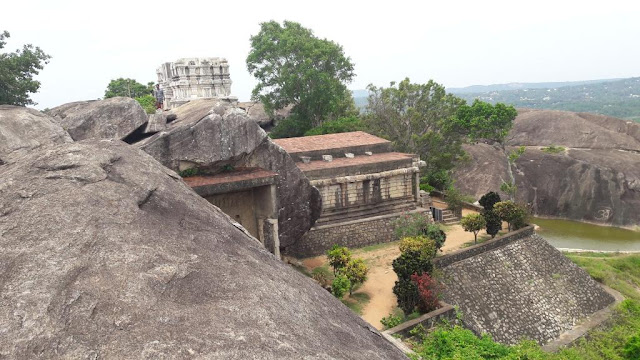Chitharal Jain Monuments – Temple Complex
There
are two monuments in this Temple complex. The earlier rock-cut Jain structure
of beads with inscriptions and drip-ledges is the earliest Jain monument in the
southernmost part of India which was from first century BC to sixth century AD.
A natural cavern formed by overhanging rock has a bas-relief sculptures of
Jain Tirthankaras which
were carved in later phase. The relief of Parshwanatha and Padmavati is standing figures canopied by multi-hooded cobra
and with attendant figures of Yaksha. The figures seated in ardha-padmasana pose in each niches with three-tiered parasol is
that of other Tirthankaras (possibly of all 24 Tirthankaras).
There
are three standing figures of Tirthankara in one of the left corner. The
central niche has a figure of Mahavira with three-tiered parasol, chhatratrayi
chaitya with a tree above it and attendant figures. There is another
female figure of Ambika in a niche next to it. It has attendant figures
including two children and a lion mount. All major niches have flying figures
of Vidyadharas or worshippers.
Each of this figures have a short inscription below the seat mentioning a name
of donor and place in Vatteluthu Tamil script.
Based on
these inscription, it is known that the site was under control of Jains at
least till middle of thirteenth century. The temple monuments were likely built
by Digambara Jains
in the ninth century when the region was under influence of Jainism. Jain influence in this region was due to the
King Mahendravarman I (610-640). The monuments are reached by roughly
hewn steps in rocks and the narrow entrance between them. On the top of the
hill, there in a cave temple with mandapa, a verandah corridor
and a Balipeedam with a kitchen (madapalli) which is carved into a
natural overhanging rock facing the west.
It has
three sanctums which houses the Tirthankara (possibly Mahavira) in middle,
goddess in the right and Parshwanatha on the left. The gopuram of the
central shrine is destroyed possibly due to lightning. The temple was built in
medieval period. There is another temple-like structure (Vimana) on the top of
the hill which is reached by climbing few steps. There is a natural pond few
steps downwards. Around 13th century, the cave temple was converted
into Hindu temple of Bhagavati. Goddess Bhagavathy (Durga) was installed in the
Chitharal caves by the Cholas in 1250 CE.
Presently,
daily morning and evening poojas are performed here. Many devotees come here to
pray to Devi. The temple is under the control of the Devasom Board of Kerala
and you need permission to go inside the temple. As you enter through the main
door, you will find three rooms inside the temple. In the middle room Goddess
Bhagavathy’s image is installed while the other two rooms remain empty.
However, you can see poojas being performed in all the three rooms.
There are many stone pillars inside the temple. In front of the temple there is a freshwater pond, which unfortunately is quite dirty, teeming with shoals of fish. It is known by the Tamil script inscription on the entrance of the mandapa dated to 475 KE (1300 AD) which says Narayanan, Tamil Appalla Varaiyan of Rajavallapuram in the Kil Vembanadu donated some money for the expense of Bhagavati temple.
According
to T. A. Gopinatha Rao who visited the monuments in 1920-21, the
inscription on the southern side says a Jain priestess called Gunandagi-
kurattigal, the disciple of Arattanemi - Bhatariyar of Peravakkudi, presented
Bhatariyar of Tiruchchanam malai with a metallic lamp stand and a golden flower
during the 28th year of reign of Vikramaditya Varaguna Pandya. It was a Jain
training centre for both males and females in past. The inscription is in old
Tamil script known as Vatteluthu.
The
Travancore Archaeological Series says that Tiruchcharanattu malai, the name of
the hills, means the hill of the Charanas. Charanas means Jain
ascetics which were living on the hills. The votive images on the rock with
inscription under each of it names an ascetic or person who carved it. It is a
centrally protected monument (N-TN-T2) maintained by Thrissur Circle of India
since 1964. It is inscribed as Bhagwati temple and Jaina bas-relief.
There
are 9 stone inscriptions in Tamil Vattezhuthu, Sanskrit and Malayalam dating
back to 9th Century A.D. One of the stone inscriptions says that there was a
Jain University at this place during 1st century BC. and Queen Kuratimarayar
had donated wealth to the university. This inscription is found in Tamil Brahmi
scriptures. You have to climb up a flight of steps to reach the top of the hill
to access the caves. Climbing the 800-m path under the blazing sun is not easy.
The
scenic beauty distracts the mind from the sweat and stickiness caused by the
humid environment. The path meanders uphill and is lined with cashew nut and
other shady trees bearing red and violet flowers. Benches are conveniently
placed here and there and beds of colorful flowers surround them. Another main
attraction at the top hill is two large rocks facing each other, and one can
explore whole beauty of the foot through the small window created by these
rocks.
From the
top, one can see or enjoy the beauty of winding rivers, lakes, fields, clusters
of villages, coconut fields, tall church spires, and the lines of Western Ghat
covered with white clouds; and is a mind-blowing scenery, which you won't get
from anywhere. Chitharal attracts Jain devotees, artists, researchers and
students from India and abroad. The scenic beauty of the rolling hills offers
opportunities for taking photos and activities like rock climbing and trekking.







































































